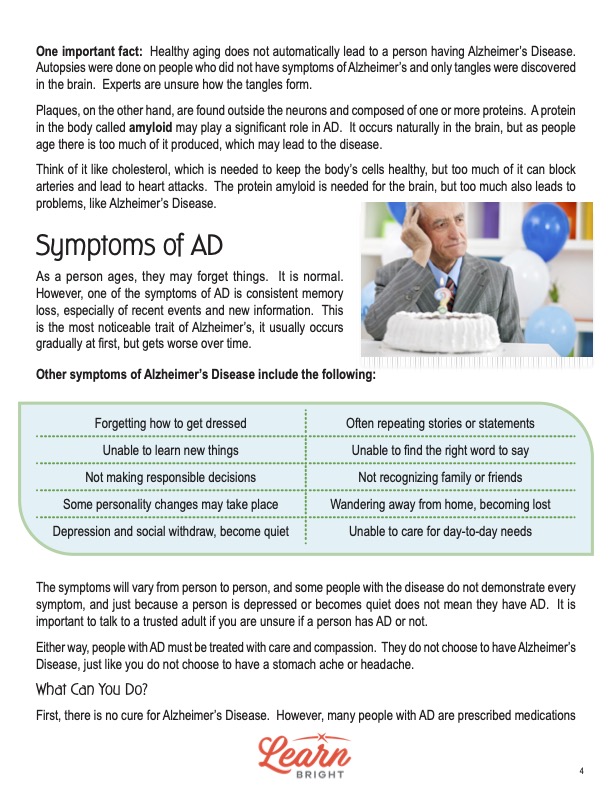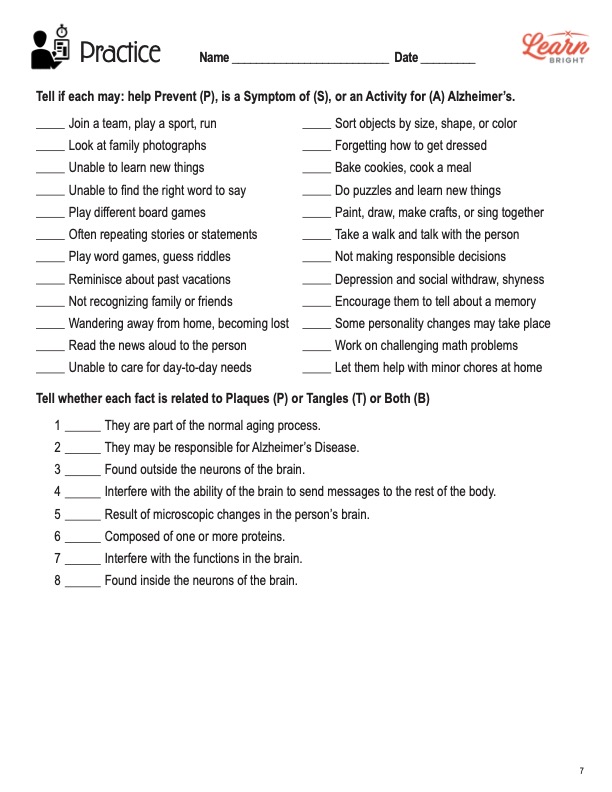Description
What our Alzheimer’s Disease lesson plan includes
Lesson Objectives and Overview: Alzheimer’s Disease teaches students about the traits and symptoms of this condition. Students will learn some strategies that would help them interact with people who suffer from this disease. They will learn that this condition is fairly common, and they might have loved ones who one day develop Alzheimer’s. This lesson is for students in 5th grade and 6th grade.
Classroom Procedure
Every lesson plan provides you with a classroom procedure page that outlines a step-by-step guide to follow. You do not have to follow the guide exactly. The guide helps you organize the lesson and details when to hand out worksheets. It also lists information in the yellow box that you might find useful. You will find the lesson objectives, state standards, and number of class sessions the lesson should take to complete in this area. In addition, it describes the supplies you will need as well as what and how you need to prepare beforehand.
Options for Lesson
There are quite a few suggestions in the “Options for Lesson” section of the classroom procedure page that you could incorporate into the lesson. One suggestion is to plan a day or week to celebrate “Alzheimer’s Awareness,” either with the class or the school. As an extra homework assignment, students could interview a caregiver or relative of someone suffering from the disease. You could also invite a caregiver or expert on the subject to speak with the class and answer their questions. Depending on the maturity level of your class, another option is for students to role-play how to treat a person with Alzheimer’s. The students, in groups of three or four, could create a script ahead of time. One more idea is to have students research other causes of dementia or memory loss and present what they discover to the class.
Teacher Notes
The paragraph on this page provides extra guidance or information as you prepare the lesson. It reminds you that the goal of this lesson is to teach students how to interact with people who suffer from AD. Ensure you are aware of any students for whom this topic may be sensitive. You can use the blank lines on this page to write down any other ideas or thoughts you have before giving the lesson to students.
ALZHEIMER’S DISEASE LESSON PLAN CONTENT PAGES
AD and the Brain
The Alzheimer’s Disease lesson plan contains three pages of content. The first page introduces the lesson by discussing the mysteries of space. Scientists have learned a lot about the universe, the solar system, stars, galaxies, and more. Despite their extensive research, NASA and other space agencies still know only a fraction of the facts. Space remains a mystery.
In much the same way, the brain is mystery as well. Of all the organs in the body, doctors and other scientists may know the least about the brain. However, neuroscientists and other experts have done a lot of research. They have explored, dissected, and studied the brain extensively. In particular, they have studied a lot about a disease of the brain that is a type of dementia: Alzheimer’s disease.
Alzheimer’s disease (AD) causes problems with memory, thinking, and behavior. Dementia in general involves a set of symptoms that include memory loss and difficulties with thinking, solving problems, or language. AD is the most common cause of dementia. About 5% to 6% of the U.S. population suffers from some form of dementia or AD. Alzheimer’s disease ranks fourth as the leading cause of death among adults. By age 85, around 50% of people will be diagnosed with AD.
The History and How It Works
The origin of the name of this disease comes from the German neurologist Alois Alzheimer. In 1906, he performed an autopsy on a woman who suffered from memory loss and other problems for the last few years of her life. He noticed microscopic changes in her brain, which he called plaques or tangles. Unfortunately, he could only see these changes during an autopsy and would not be able to find them while a person was alive.
Alzheimer’s disease attacks the brain. The plaques interfere with functions in the brain, such as its ability to send messages to various parts of the body. Tangles, on the other hand, form as part of the normal aging process inside the neurons of the brain. In other words, it is an inevitable part of growing old. The question researching struggle to answer is whether the plaques alone play a part in AD or the issue has to do with the interactions between plaques and tangles.
The lesson explains that healthy aging does not automatically lead to the development of Alzheimer’s disease. Medical examiners have performed autopsies on people who did not show symptoms of AD, and they discovered only tangles. Experts are still unsure how exactly tangle form. Plaques, on the other hand, are outside of neurons and comprise one or more proteins. Experts believe that a specific protein in the body called amyloid may play a significant role in AD. It occurs naturally in the brain. But as people age, the brain produces too much of it, which may lead to the disease.
Symptoms of Alzheimer’s Disease
Students will learn that as people age, they tend to forget things. This is a completely normal thing. Consistent memory loss, however, is a symptom of AD, especially when the things people forget are about recent events or new information. This is actually the most noticeable trait of the disease. It usually occurs gradually at first but worsens over time.
Other symptoms include forgetting simple tasks, such as how to get dressed, or repeating the same stories and statements. Sometimes people with AD struggle to learn new things, find the right words to say, or make responsible decisions. Other people wander away from home and get lost or develop changes in their personalities. Depression, withdrawal from social settings, and getting quiet are also symptoms. People may also lose their ability to take care of day-to-day needs.
The symptoms vary from person to person. People may not demonstrate every symptom of the disease. And just because someone displays some of these symptoms, such as depression and withdrawal, it doesn’t necessarily mean they have Alzheimer’s. Regardless, it is important to treat people who have AD with care and compassion.
What Can You Do?
The last section of the lesson describes a few strategies students can implement when interacting with individuals with AD. It also lists ways to help prevent the disease in the first place. There is no cure for Alzheimer’s disease, but there are medications that help. Furthermore, there are activities we can do with someone who has AD to help them as well.
The lesson lists 10 ideas of activities to do with people with AD:
- Look at family photographs.
- Read the news aloud.
- Sort objects by size, shape, or color.
- Take a walk and talk.
- Play different board games.
- Reminisce about past vacations.
- Let the person help with minor chores around the house.
- Bake cookies or cook a meal together.
- Encourage the person to talk about a memory.
- Paint, draw, make crafts, or sing together.
Students will discover that the human brain constantly makes new connections, which strengthens the brain. One way to help prevent Alzheimer’s as we age is to produce new connections. To do so, we have to stay active, both mentally and physically. Exercising the brain, just as we do with our bodies, helps build connections and make the brain stronger and better.
There are many ways to engage our minds and exercise mentally, regardless of age. Puzzles, word games, riddles, math problems, and more are great mental exercises to help keep the brain working. Physical exercise is actually just as important. It is better to run, jump, and play than to sit in front of a TV or phone screen for long periods of time.
ALZHEIMER’S DISEASE LESSON PLAN WORKSHEETS
The Alzheimer’s Disease lesson plan includes three worksheets: an activity worksheet, a practice worksheet, and a homework assignment. Each of these handouts will help solidify students’ comprehension of the content. You can refer to the classroom procedure guide to determine when to give students each worksheet throughout the lesson.
TWO POSTERS ACTIVITY WORKSHEET
Students will work with a partner for the activity. They will work together to create two posters. One will be a “compassion poster” that informs people why caring for people with AD is important. The other poster will be a “prevent Alzheimer’s poster” that encourages people to do things that will help keep their brains healthy and active. There are blank squares at the bottom of the worksheet for students to use as scratch paper.
PLAQUES AND TANGLES PRACTICE WORKSHEET
There are two sections on the practice worksheet. The first section requires students to review 24 statements. Students will describe whether the description is a way to help prevent (P) AD, is a symptom (S) of AD, or is an activity (A) to enjoy with someone who has AD. The section section requires students to tell whether each fact relates to plaques (P), tangles (T), or both (B).
ALZHEIMER’S DISEASE HOMEWORK ASSIGNMENT
For the homework assignment, students will first match definitions to the correct terms. There is a total of eight definitions and terms to match in this section. The next part requires students to tell whether each statement is true (T) or false (F). There are 12 statements in this section.
Worksheet Answer Keys
The last two pages of the lesson plan document are answer keys for the practice and homework worksheets. The correct answers for both pages are in red to make it easy for you to compare with students’ responses. If you choose to administer the lesson pages to your students via PDF, you will need to save a new file that omits these pages. Otherwise, you can simply print out the applicable pages and keep these as reference for yourself when grading assignments.










